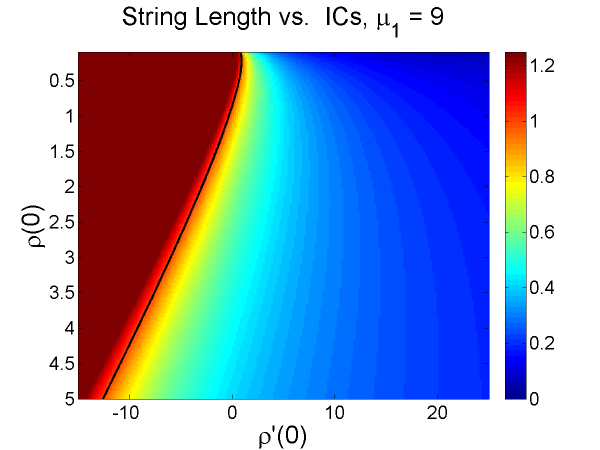| << Chapter < Page | Chapter >> Page > |



In solving the initial-value problem described in "Changing From Potential to Density" , uniqueness concerns pose the question,"Does a single Sturm-Liouville potential give rise to a single mass density?" As it turns out, no. We see that a single Sturm-Liouville potential can give rise to a set of mass densities, dependent upon the initial conditions and and the length of the recovered string, . [link] shows a color mapping of recovered string length against various initial conditions. The length of the string cannot be known before the initial-value problem is solved; therefore, in order to obtain these color maps, we fix the initial conditions and obtain the length of the string at the end of the change of variables computation. All string lengths are indicated on the map as 1.25. We show this result for the transformation of three potential functions, those defined by the aforementioned spectra with . In our case, we desire strings of length one.The curve shown in black on the color maps indicates the set of initial conditions and that yield a string of unit length. Alongside this module, in the featured links, we have posted a movie of this color map with changing from 1 to 15 by 0.1007.



We can determine, from the curve in the color plot, a corresponding to any that will yield a string with for a given . However, we do not use this means. Instead, we choose and use a bisection algorithm, solving the ODE at each iteration, to find such that . The bisection algorithm is consistently called with error tolerance . In the results below, we set for each -determined potential. [link] shows the mass density functions found in this way, which correspond to the Sturm-Liouville potentials of [link] . We have also included a movie in the featured links that shows the mass density with and from potentials determined by changing from 1 to 37.4 by tenths. (The second eigenvalue in the Dirichlet spectrum for [link] is . The closer we make to the second eigenvalue, the harder it is to numerically compute the transformations. Making was as close to as we were able to compute the transformations.)



It is also interesting to view a sampling of the isospectral set of mass densities corresponding to a given . Figures [link] and [link] contain four isospectral mass densities, each corresponding to the Sturm-Liouville potential in [link] with specified as in the other figures and varying values of .




We have made the claim that the eigenvalues of the Sturm-Liouville operator specified by are the same as those of the wave equation specified by the corresponding . To demonstrate this, we consider the eigenvalue problem in [link] . The eigenpairs can be numerically obtained via spectral methods. We build a differential matrix, , over a Chebyshev discretization of the interval and in MATLAB solve the linear system:

Notification Switch
Would you like to follow the 'The art of the pfug' conversation and receive update notifications?